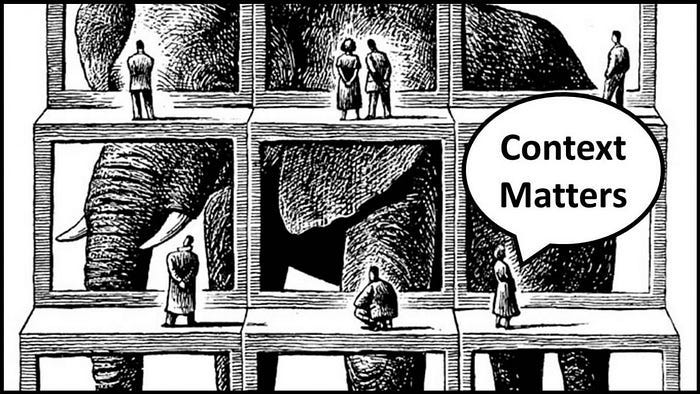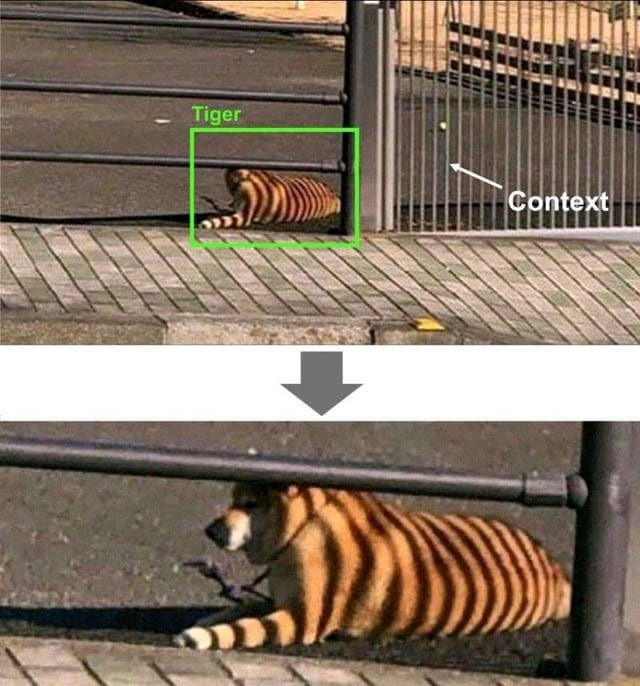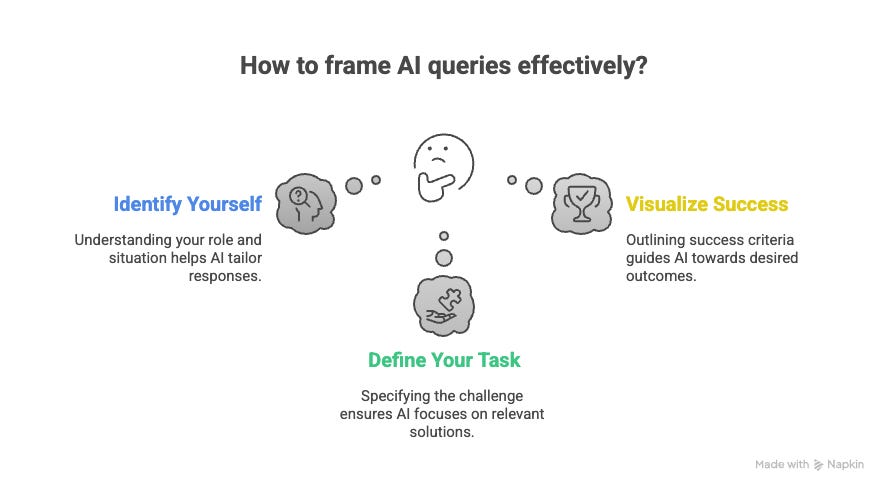Most Use 10% of AI's Capability - Here's How to Access the Other 90%
Most leaders prompt AI like Google. Here's what power users do differently
Thanks for reading! To access our community, full prompt library, coaching, and AI tools saving leaders 5-10 hours per week, check out our Premium Hub.
I just saved 18 hours of strategic planning work with one AI prompt.
Not because I have special access to better AI tools than most, or higher tiers in plans of ChatGPT and Claude. This is simply because I stopped prompting AI like Google and started prompting it like I’d brief a strategic consultant.
Same AI everyone else uses. Different results. The gap? Context.
Research on AI interactions confirms what I’ve learned through hundreds of hours testing these tools:
The quality of your prompts directly determines the value of the AI’s response.
Think about it like this: Imagine hiring a strategic consultant with an MBA, 20 years of industry experience, and deep expertise in your sector. Then only asking them yes-or-no questions. Never telling them about your organization. Never sharing your challenges. Never explaining what success looks like for you.
You’d get surface-level answers, generic advice, nothing you couldn’t find in a basic business book.
That’s what happens when you prompt AI like Google search.
You’re probably treating AI like a search engine…
type a question
get an answer
move on.
The problem isn’t the technology. The problem is that AI knows nothing about you. So it gives you what it gives everyone: responses that sound helpful but lack any strategic depth. Cookie-cutter advice that could apply to anyone, anywhere.
Research shows something surprising: A smaller, older AI model with rich context about your work will consistently outperform the largest, newest model that knows nothing about you. The secret to unlocking 10x better results isn’t in what you ask. It’s in what the AI already knows about you before you start typing.
That’s the 90% you’re probably not accessing. Not because it’s complicated, because you don’t realize context is the missing ingredient.
In this post, you’ll learn:
Why your current prompts only tap 10% of AI’s capability (and what’s blocking the other 90%)
The one missing ingredient that changes AI from generic tool to strategic partner
How context works, without requiring technical expertise
Why AI Keeps Giving You Generic Advice
Here’s the reality you’re probably missing: Every AI model (ChatGPT, Claude, Gemini) has vast knowledge from its training. Leadership theory, business frameworks, nonprofit best practices, and change management principles.
But it knows nothing about your specific situation.
It doesn’t know your organization’s mission. It doesn’t know your team’s dynamics. It doesn’t know the challenges you’re navigating right now. It doesn’t know what success looks like in your context.
So when you ask it a question with zero context, it gives you the only thing it can: one-size-fits-all advice.
This is what researchers call the “Foundation Problem.” The AI’s foundation is generic training data. Without your specific context added to that foundation, you’re stuck at 10% results.
You’ve probably experienced this and blamed the AI. “It’s giving me surface-level stuff.” “This sounds like it was written by a robot.” “I could have found this on Google.”
The AI isn’t the problem. The prompt is.
Brought to you by COZORA👇. Get up to 50% off with the coupon in the Premium Hub.
What Context Actually Means (And How to Add It)
Let me translate this into plain language, because “context” sounds like tech jargon.
Context = teaching AI about your specific situation before you even ask your question.
That’s it. Nothing complicated.
When you prompt AI like Google—”How do I improve customer engagement?”—you’re giving zero context. The AI has to guess:
What kind of organization you lead
Who your customers are
What you’ve already tried
What constraints you’re working within
What success would actually look like for you
So it gives you generic engagement advice that could apply to any org. anywhere.
Research confirms this: “What matters right now is not the size or sophistication of the model. What matters is how much context you give it.”
Here’s what context looks like in practice:
Instead of:
“How do I improve donor engagement?”
Try:
“I lead a $2M healthcare nonprofit. Our average donor is 55+, gives $100-500 annually, and responds better to impact stories than efficiency metrics. We’ve tried monthly newsletters but open rates are dropping. How do I improve engagement specifically with this donor profile?”
Same AI. Same basic question. Completely different quality of response.
The three types of context that matter:
1. Who You Are
Not just your job title… your actual situation. “I’m an executive director at a $2M nonprofit with 8 staff members, serving rural communities, navigating our first significant leadership transition.”
2. What You’re Working On
The specific challenge, not a generic goal. “I need a strategy to retain younger donors who give smaller amounts but could become major supporters over time.”
3. What Success Looks Like
What constraints matter? What outcomes would you celebrate? “Our board wants something they can understand in 5 minutes,” or “We need something our volunteers can implement without technical training.”
💡 THE CONTEXT FRAMEWORK
Before asking AI anything, answer these three questions:
WHO AM I? (Not just title—actual situation)
WHAT AM I WORKING ON? (Specific challenge, not generic goal)
WHAT DOES SUCCESS LOOK LIKE? (Constraints and outcomes that matter)
Add one sentence covering each. Your AI responses will change dramatically.
My Wake-Up Moment
I started using AI tools casually. Like everyone else. Quick questions, quick answers, move on.
The results? Fine for basic tasks. Nothing impressive. Nothing that made me think “this is revolutionary.”
But over the past year and a half, I got frustrated enough to experiment. What if I stopped blaming the AI and started giving it better information?
The results were specific and measurable:
Research that used to take me 6 hours now takes 45 minutes
Content briefs that required three revision rounds now nail it on the first try
Strategic frameworks that I’d spend days developing now emerge in 20-minute conversations
Not because I’m using different AI tools. Because I stopped forcing it to guess about my context. I started telling it.
I had to learn what context actually matters. Not your life story. Just the three pieces of information that help AI understand your specific situation.
When AI knows who you are and what you need, it stops giving you one-size-fits-all advice and starts giving you strategic thinking tailored to your actual situation.
The 10% Prompt vs. The 70% Prompt
Stop for a second. Look at these two prompts side-by-side.
10% Prompt (No Context):
Write a strategy memo about implementing AI in our organization.AI Response: Generic corporate AI implementation framework. Could apply to any organization. Talks about “efficiency gains” and “digital transformation” and “change management.” Nothing specific. Nothing actionable. Classic AI slop.
70% Prompt (With Context):
I’m the executive director of a regional food bank serving 50,000 people monthly. Our board (mostly 60+ with traditional business backgrounds) is curious but skeptical about AI. Our biggest operational challenge is volunteer coordination—we have 200+ volunteers with varying schedules and skills, and matching them to needs is currently manual and time-consuming.
Write a strategy memo for our board that explains how AI could help specifically with volunteer coordination. Focus on practical implementation, not theory. Address likely concerns about technology replacing human connection. Keep it under 500 words.AI Response: Specific strategy tailored to food bank operations. Addresses board’s age and background. Focuses on one concrete problem with practical solutions. Anticipates skepticism about technology replacing human touch. Actually usable.
Same AI model. Same basic task. One prompt gave 10% results. The other gave 70%+.
The difference? Context. Thirty seconds of additional information unlocked 90% more value.
Copy-Paste Prompt Template
💡 Use this template for any AI request:
I’m [your role] at [type of organization] serving [who you serve].
My biggest challenge right now is [specific problem].
My audience/stakeholders are [who needs to understand this] and they care most about [what matters to them].
Help me [specific task] that addresses this situation specifically.Example using this template:
I’m the executive director at a regional food bank serving 50,000 people monthly through 200+ volunteers.
My biggest challenge right now is volunteer coordination—matching varying schedules and skills to needs is manual and time-consuming.
My audience is our board (mostly 60+ with traditional business backgrounds) who are curious but skeptical about AI, especially concerned about technology replacing human connection.
Help me draft a 500-word strategy memo explaining how AI could specifically help with volunteer coordination while addressing concerns about maintaining the human element of our work.This template gets you started. But here’s what I’ve learned: most leaders need more than one template. That’s why I built the Premium Member Hub with 15+ context-rich prompt templates for every leadership scenario, plus advanced frameworks for building your own AI systems.
Limited time: I’m offering premium member pricing at the lowest discount ever, for a few days.
If you’re ready to move from experimenting with one-off prompts to building a systematic approach that saves you hours every week, this is your next step.
Your Monday Morning Action
Open ChatGPT, Claude, or whatever AI tool you use. Find one prompt you’ve used in the past week that gave you generic results.
Now rewrite it. Add one sentence about who you are and what you’re actually trying to accomplish.
Run both prompts. Compare the responses side-by-side.
The difference will convince you faster than anything I can write here.
If You Only Remember This
The quality of your AI responses is determined by the quality of your prompts—and quality means context, not complexity
You’re probably stuck at 10% results because you prompt AI like Google (quick questions, zero context, cookie-cutter answers)
Context = teaching AI three things: who you are, what you’re working on, and what success looks like
One sentence of context before your question changes everything: AI goes from guessing to actually helping you think strategically
What’s one prompt you use regularly where adding context would change the response you get?
PS: Many subscribers get their Premium membership reimbursed through their company’s professional development $. Use this template to request yours.
Let’s Connect
I love connecting with people. Please use the following connect, collaborate, if you have an idea, or just want to engage further:
LinkedIn / Community Chat / Email / Medium








“This is what researchers call the “Foundation Problem.” The AI’s foundation is generic training data. Without your specific context added to that foundation, you’re stuck at 10% results.”
Double down on this I see it too often. Great article thanks!
Treating AI like a consultant instead of a search engine is the simplest, most overlooked shift for leaders.